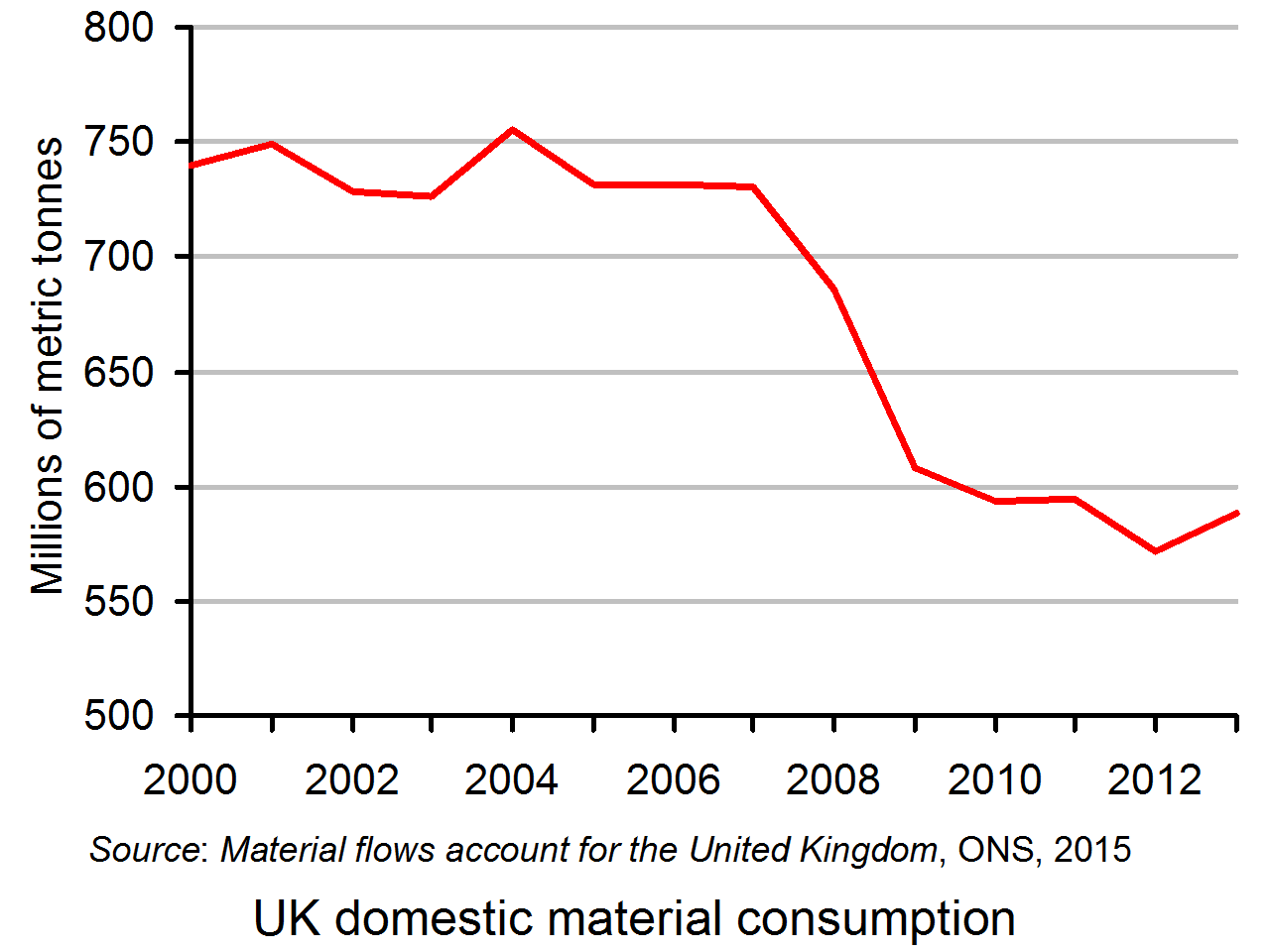 In the blog post, Global warning, we looked at the use of unconventional macroeconomic policies to deal with the slow pace of economic growth around the world. One of the articles was by Nouriel Roubini. In the linked article below, he argues that slow economic growth may be the new global norm.
In the blog post, Global warning, we looked at the use of unconventional macroeconomic policies to deal with the slow pace of economic growth around the world. One of the articles was by Nouriel Roubini. In the linked article below, he argues that slow economic growth may be the new global norm.
At the centre of the problem is a fall in the rate of potential economic growth. This has been caused by a lack of investment, which has slowed the pace of innovation and the growth in labour productivity.
The lack of investment, in turn, has been caused by a lack of spending by both households and governments. What is the point in investing in new capacity, argue firms, if they already have spare capacity?
Low consumer spending is partly the result of a redistribution of income from low- and middle-income households (who have a high marginal propensity to consume) to high-income households and corporations (who have a low mpc). Low spending is also the result of both consumers and governments attempting to reduce their levels of debt by cutting back spending.
Low growth leads to hysteresis – the process whereby low actual growth leads to low potential growth. The reason is that the unemployed become deskilled and the lack of investment by firms reduces the innovation that is necessary to embed new technologies.
Read Roubini’s analysis and consider the policy implications.
Article
Has the global economic growth malaise become the ‘new normal’? The Guardian, Nouriel Roubini (2/5/16)
Questions
- Explain what is meant by ‘hysteresis’ and how the concept is relevant in explaining low global economic growth.
- Why has there been a reduction in the marginal propensity to consume in recent years? What is the implication of this for the multiplier and economic recovery?
- Explain what Roubini means by ‘a painful de-leveraging process’. What are the implications of this process?
- How important are structural reforms and what forms could these take? Why has there been a reluctance for governments to institute such reforms?
- ‘Asymmetric adjustment between debtor and creditor economies has also undermined growth.’ Explain what Roubini means by this.
- Why are governments reluctant to use fiscal policy to boost both actual and potential economic growth?
- What feasible policy measures could be taken to boost actual and potential economic growth?
 It doesn’t seem long ago that we were looking at the prospects of Brazil for hosting the Football World Cup. Now, we turn to the same economy, but this time for the Olympics. It is often the case that hosting big global sporting events can give a boost to the host nation, but is Brazil prepared for it? Did the World Cup bring the expected economic boosts? Some argue that the Olympics is just what Brazil needs, but others suggest it will only worsen the economic situation in the world’s seventh largest economy.
It doesn’t seem long ago that we were looking at the prospects of Brazil for hosting the Football World Cup. Now, we turn to the same economy, but this time for the Olympics. It is often the case that hosting big global sporting events can give a boost to the host nation, but is Brazil prepared for it? Did the World Cup bring the expected economic boosts? Some argue that the Olympics is just what Brazil needs, but others suggest it will only worsen the economic situation in the world’s seventh largest economy.
Brazil’s economic performance in the past year was not good. In fact, it was one of the worst performing nations of any major economy, with GDP falling by 3%. This is a very different country from the one that was awarded this biggest of sporting events. Despite these difficult times, Brazil’s government maintains that the country is ready and that the games will be ‘spectacular’.
Key to hosting a sporting event such as the Olympics is the infrastructure investment and as a key component of aggregate demand, this should be a stimulant for growth and job creation. However, with the economy still struggling, many are concerned that the infrastructure won’t be in place in time.
Other benefits from this should be the boost to growth driven by athletes and spectators coming from around the globe, buying tickets, memorabilia, accommodation, food and other items that tourists tend to buy. A multiplier effect should be seen and according to research has the potential to create significant benefits for the whole economy and not just the local regions where events take place. You can look at similar analysis in blogs written about Tokyo: 2020 Tokyo Olympics and London: The London Olympics legacy: a cost–benefit analysis and Does hosting the Olympics Games increase economic growth?
But, is this really likely to happen, especially given the somewhat lacklustre boost that the Brazil World Cup gave to the economy? The following articles consider this.
Rio 2016: Can Games bounce back from Brazil economic woes? BBC News, Bill Wilson (11/03/16)
Does hosting the Olympics actually pay off? It’s the economy, Binyamin Applebaum (5/08/14)
Rio Olympics no help to Brazil economy based on World Cup Bloomberg, Raymond Colitt (16/01/15)
The economic impact of Brazil’s 2014 World Cup and 2016 Olympics Saxo Group, Trading Floor, Sverrir Sverrisson (27/08/12)
Special Interview: Cost–benefit analysis of hosting the World Cup, Olympics Al Arabiya, Ricardo Guerra (3/7/14)
Questions
- How might you carry out a cost–benefit analysis to decide whether to host a big sporting event?
- Are there any externalities that might result from hosting the Olympics? How easy is it to estimate their monetary value? Should this be taken into account by a country when making a decision?
- Why might there be a boost to aggregate demand prior to the Olympics?
- Why might there be a multiplier effect when a nation hosts the Olympics or another sporting event?
- Might there be benefits to Brazil’s neighbours from its hosting the Olympics?
 In an attempt to prevent recession following the financial crisis of 2007–8, many countries adopted both expansionary monetary policy and expansionary fiscal policy – and with some success. It is likely that the recession would have been much deeper without such policies
In an attempt to prevent recession following the financial crisis of 2007–8, many countries adopted both expansionary monetary policy and expansionary fiscal policy – and with some success. It is likely that the recession would have been much deeper without such policies
But with growing public-sector deficits caused by the higher government expenditure and sluggish growth in tax receipts, many governments soon abandoned expansionary fiscal policy and relied on a mix of loose monetary policy (with ultra low interest rates and quantitative easing) but tight fiscal policy in an attempt to claw down the deficits.
But such ‘austerity’ policies made it much harder for loose monetary policy to boost aggregate demand. The problem was made worse by the attempt of both banks and individuals to ‘repair’ their balance sheets. In other words banks became more cautious about lending, seeking to build up reserves; and many individuals sought to reduce their debts by cutting down on spending. Both consumer spending and investment were slow to grow.
And yet government and central banks, despite the arguments of Keynesians, were reluctant to abandon their reliance solely on monetary policy as a means of boosting aggregate demand. But gradually, influential international institutions, such as the IMF (see also) and World Bank, have been arguing for an easing of austerity fiscal policies.
 The latest international institution to take a distinctly more Keynesian stance has been the Organisation for Economic Co-operation and Development (OECD). In its November 2015 Economic Outlook it had advocated some use of public-sector investment (see What to do about slowing global growth?. But in its Interim Economic Outlook of February 2016, it goes much further. It argues that urgent action is needed to boost economic growth and that this should include co-ordinated fiscal policy. In introducing the report, Catherine L Mann, the OECD’s Chief Economist stated that:
The latest international institution to take a distinctly more Keynesian stance has been the Organisation for Economic Co-operation and Development (OECD). In its November 2015 Economic Outlook it had advocated some use of public-sector investment (see What to do about slowing global growth?. But in its Interim Economic Outlook of February 2016, it goes much further. It argues that urgent action is needed to boost economic growth and that this should include co-ordinated fiscal policy. In introducing the report, Catherine L Mann, the OECD’s Chief Economist stated that:
“Across the board there are lower interest rates, except for the United States. It allows the authorities to undertake a fiscal action at very very low cost. So we did an exercise of what this fiscal action might look like and how it can contribute to global growth, but also maintain fiscal sustainability, because this is an essential ingredient in the longer term as well.
 So we did an experiment of a two-year increase in public investment of half a percentage point of GDP per annum undertaken by all OECD countries. This is an important feature: it’s everybody doing it together – it’s a collective action, because it’s global growth that is at risk here – our downgrades [in growth forecasts] were across the board – they were not just centred on a couple of countries.
So we did an experiment of a two-year increase in public investment of half a percentage point of GDP per annum undertaken by all OECD countries. This is an important feature: it’s everybody doing it together – it’s a collective action, because it’s global growth that is at risk here – our downgrades [in growth forecasts] were across the board – they were not just centred on a couple of countries.
So what is the effect on GDP of a collective fiscal action of a half a percentage point of GDP [increase] in public investment in [high] quality projects. In the United States, the euro area, Canada and the UK, who are all contributors to this exercise, the increase in GDP is greater than the half percentage point [increase] in public expenditure that was undertaken. Even if other countries don’t undertake any fiscal expansion, they still get substantial increases in their growth rates…
Debt to GDP in fact falls. This is because the GDP effect of quality fiscal stimulus is significant enough to raise GDP (the denominator in the debt to GDP ratio), so that the overall fiscal sustainability [debt to GDP] improves.”
What is being argued is that co-ordinated fiscal policy targeted on high quality infrastructure spending will have a multiplier effect on GDP. What is more, the faster growth in GDP should outstrip the growth in government expenditure, thereby allowing debt/GDP ratios to fall, not rise.
This is a traditional Keynesian approach to tackling sluggish growth, but accompanied by a call for structural reforms to reduce inefficiency and waste and improve the supply-side of the economy.
Articles
Osborne urged to spend more on infrastructure by OECD Independent, Ben Chu (18/2/16)
OECD blasts reform fatigue, downgrades growth and calls for more rate cuts Financial Review (Australia), Jacob Greber (18/2/16)
OECD calls for less austerity and more public investment The Guardian, Larry Elliott (18/2/15)
What’s holding back the world economy? The Guardian, Joseph Stiglitz and Hamid Rashid (8/2/16)
OECD calls for urgent action to combat flagging growth Financial Times, Emily Cadman (18/2/16)
Central bankers on the defensive as weird policy becomes even weirder The Guardian, Larry Elliott (21/2/16)
Keynes helped us through the crisis – but he’s still out of favour The Guardian, Larry Elliott (7/2/16)
G20 communique says monetary policy alone cannot bring balanced growth
Reuters (27/2/15)
OECD publications
 Global Economic Outlook and Interim Economic Outlook OECD, Catherine L Mann (18/2/16)
Global Economic Outlook and Interim Economic Outlook OECD, Catherine L Mann (18/2/16)
Interim Economic Outlook OECD (18/2/16)
Questions
- Draw an AD/AS diagram to illustrate the effect of a successful programme of public-sector infrastructure projects on GDP and prices.
- Draw a Keynesian 45° line diagram to illustrate the effect of a successful programme of public-sector infrastructure projects on actual and potential GDP.
- Why might an individual country benefit more from a co-ordinated expansionary fiscal policy of all OECD countries rather than being the only country to pursue such a policy?
- What determines the size of the multiplier effect of such policies?
- How might a new classical/neoliberal economist respond to the OECD’s recommendation?
- Why may monetary policy have ‘run out of steam’? Are there further monetary policy measures that could be adopted?
- Compare the relative effectiveness of increased government investment in infrastructure and tax cuts as alterative forms of expansionary fiscal policy.
- Should quantitative easing be directed at financing public-sector infrastructure projects? What are the benefits and problems of such a policy? (See the blog post People’s quantitative easing.)
 As most developed countries continue to experience relatively low rates of economic growth by historical standards, governments and central banks struggle to find means of stimulating aggregate demand.
As most developed countries continue to experience relatively low rates of economic growth by historical standards, governments and central banks struggle to find means of stimulating aggregate demand.
One explanation of sluggish growth in demand is that people on higher incomes have enough of most things. They have reached ‘peak stuff’. As the Will Hutton article linked below states:
Around the developed world consumers seem to be losing their appetite for more. Even goods for which there once seemed insatiable demand seem to be losing their lustre. Last week, mighty Apple reported that in the last three months of 2015 global sales of the iPhone stagnated, while sales of iPads tumbled from 21m units in 2014 to 16m in the same three months of 2015. In the more prosaic parts of the economy – from cars to home furnishings – there are other warnings that demand is saturated.
People on lower incomes may still want more, but with income inequality growing in most countries, they don’t have the means of buying more. Indeed, a redistribution from rich to poor may be an effective means of increasing aggregate demand and stimulating economic growth.
 It’s important to clarify what is meant by peak demand for such products. It is not being said that people will stop buying them – that future demand will be zero. People will continue to buy such products. In the case of durables, people will buy replacements when products such as furniture, fridges and cars wear out; or upgraded versions as new models of televisions, smartphones or, again, cars come out; or new music tracks or films as they become available for download, or clothing as new fashions appear in shops. In the case of foodstuffs, concerts, football matches and other consumables, they too will continue to be purchased. The point is, in the case of peak demand, the demand per period of time is not going to grow. And the more products there are that reach peak demand, the harder it will be for companies and economies to grow.
It’s important to clarify what is meant by peak demand for such products. It is not being said that people will stop buying them – that future demand will be zero. People will continue to buy such products. In the case of durables, people will buy replacements when products such as furniture, fridges and cars wear out; or upgraded versions as new models of televisions, smartphones or, again, cars come out; or new music tracks or films as they become available for download, or clothing as new fashions appear in shops. In the case of foodstuffs, concerts, football matches and other consumables, they too will continue to be purchased. The point is, in the case of peak demand, the demand per period of time is not going to grow. And the more products there are that reach peak demand, the harder it will be for companies and economies to grow.
 If peak demand has generally been reached, it is likely that the demand for material resources will also have peaked. Indeed, we could expect the demand for material resources to be declining as (a) there has also been an increase in the efficiency of production, so that a lower volume of material inputs is required to produce any given level of output and (b) there has been a general switch towards services and away from physical goods. The graph shows domestic material consumption in the UK in millions of metric tonnes. Domestic material consumption is defined as domestic extraction of resources minus exports of resources plus imports of resources. As you can see, domestic material consumption peaked in 2004.
If peak demand has generally been reached, it is likely that the demand for material resources will also have peaked. Indeed, we could expect the demand for material resources to be declining as (a) there has also been an increase in the efficiency of production, so that a lower volume of material inputs is required to produce any given level of output and (b) there has been a general switch towards services and away from physical goods. The graph shows domestic material consumption in the UK in millions of metric tonnes. Domestic material consumption is defined as domestic extraction of resources minus exports of resources plus imports of resources. As you can see, domestic material consumption peaked in 2004.
But, although peak demand may have been reached in some markets, there are others where there is still the potential for growth. To understand this and identify where such markets may be, it is important to step back from simple notions of consumption to satisfy materialistic demand and focus on the choices people might make to increase their happiness or wellbeing or sense of self worth in society. Thus while we might have reached peak red meat, peak sugar, peak cars, peak furniture and even peak electronic gadgets, we have not reached peak demand for more satisfying experiences. The demand for education, health, social activities, environmental conservation and a range of fulfilling experiences may have considerable potential for growth.
There are business opportunities here, whether in the leisure industry, in building networks of like-minded people or in producing niche goods that satisfy the demands of people with specific interests. But without greater equality there may be many fewer business opportunities in the mass production industries producing standardised goods.
This is not a world in which goods and services are produced at scale as conventionally measured, but a honeycomb economy of niches and information networks whose new dynamics we barely understand, even if we have a better grasp of its values.
Articles
- If having more no longer satisfies us, perhaps we’ve reached ‘peak stuff’
The Guardian, Will Hutton (31/1/16)
- Steve Howard, Ikea Exec, Says The World Has Hit ‘Peak Stuff’
Huffington Post, Zi-Ann Lum (20/1/16)
- We’ve hit peak home furnishings, says Ikea boss
The Guardian, Sean Farrell (18/1/16)
- Peak stuff: the ‘growth’ party is over. So what next?
The Ecologist, Bennet Francis and Rupert Read (22/1/16)
- Have we reached peak ‘stuff’?
The Mancunion, Tristan Parsons (22/2/16)
- Ikea senses room to grow amid ‘peak stuff’
Financial Times, Aliya Ram and Richard Milne (18/1/16)
- Peak Stuff
ifs insights, Janet Hontoir (21/2/16)
- UK retail sales soar as Brits splash their cash on ‘fun stuff’
The Telegraph, Szu Ping Chan (19/2/16)
- How less stuff could make us happier – and fix stagnation
The Guardian, Katie Allen (26/4/16)
Questions
- What are the implications of countries reaching ‘peak stuff’ for (a) the marginal utility of mass produced goods; (b) the marginal propensity to consume and the multiplier?
- Give some examples of goods or services where peak stuff has not been reached.
- If peak stuff has only been reached for certain products, does this mean that there may still be considerable potential for stimulating aggregate demand without a redistribution of income?
- Would it be in the interests of companies such as Asda to make a unilateral decision to pay their workers more? Explain why or why not.
- Why may we be a long way from reaching peak demand for housing, even without a redistribution of income?
- Make out a case for and against tax cuts as a way of stimulating (a) economic growth and (b) a growth in wellbeing? Do your arguments depend on which taxes are cut? Explain.
- The Ecologist article states that “Attaining one-planet living will probably involve in due course achieving degrowth in countries such as ours: building down our economy to a safe level.” Could such an objective be achieved through a mixed market economy? If so, how? If not, why not?
- Does the Telegraph article suggest that peak stuff has not yet been reached as far as most UK consumers are concerned?
 First the IMF in its World Economic Outlook, then the European Commission in its Economic Forecasts (see also) and now the OECD in its Economic Outlook (see also) – all three organisations in the latest issues of their 6-monthly publications are predicting slower global economic growth than they did 6 months previously. This applies both to the current year and to 2016. The OECD’s forecast for global growth this year is now 2.9%, down from the 3.7% it was forecasting a year ago. Its latest growth forecast for 2016 is 3.3%, down from the 3.9% it was forecasting a year ago.
First the IMF in its World Economic Outlook, then the European Commission in its Economic Forecasts (see also) and now the OECD in its Economic Outlook (see also) – all three organisations in the latest issues of their 6-monthly publications are predicting slower global economic growth than they did 6 months previously. This applies both to the current year and to 2016. The OECD’s forecast for global growth this year is now 2.9%, down from the 3.7% it was forecasting a year ago. Its latest growth forecast for 2016 is 3.3%, down from the 3.9% it was forecasting a year ago.
Various reasons are given for the gloomier outlook. These include: a dramatic slowdown in global trade growth; slowing economic growth in China and fears over structural weaknesses in China; falling commodity prices (linked to slowing demand but also as a result of increased supply); austerity policies as governments attempt to deal with the hangover of debt from the financial crisis of 2007/8; low investment leading to low rates of productivity growth despite technological progress; and general fears about low growth leading to low spending as people become more cautious about their future incomes.
 The slowdown in trade growth (forecast to be just 2% in 2015) is perhaps the most worrying for future global growth. As Angel Gurría, OECD Secretary-General, states in his remarks at the launch of the latest OECD Economic Outlook:
The slowdown in trade growth (forecast to be just 2% in 2015) is perhaps the most worrying for future global growth. As Angel Gurría, OECD Secretary-General, states in his remarks at the launch of the latest OECD Economic Outlook:
‘Global trade, which was already growing slowly over the past few years, appears to have stagnated and even declined since late 2014, with the weakness centering increasingly on emerging markets, particularly China. This is deeply concerning as robust trade and global growth go hand in hand. In 2015 global trade is expected to grow by a disappointing 2%. Over the past five decades there have been only five other years in which trade growth has been 2% or less, all of which coincided with a marked downturn of global growth.’
So what policies should governments pursue to stimulate economic growth? According to Angel Gurría:
‘Short-term demand needs to be supported and structural reforms to be pursued with greater ambition than is currently the case. Three specific actions are key:
|
|
| • |
First, we need to resist and turn back rising protectionism. Trade strengthens competition and investment and revs up the “diffusion machine” – the spread of new technologies throughout the economy – which will ultimately lift productivity. |
| • |
Second, we need to step up structural reform efforts, which have weakened in recent years. And here, I mean the whole range of structural reforms – education, innovation, competition, labour and product market regulation, R&D, taxes, etc. |
| • |
Third, there is scope to adjust public spending towards investment. If done collectively by all countries, if the sector and projects chosen have high multipliers, and if combined with serious structural reforms, stronger public investment can give a boost to growth and employment and not increase the relative debt burden.’ |
 On this third point, the OECD Economic Outlook argues that ‘the rationale for such investments is that they could help to push economies onto a higher growth path than might otherwise be the case, at a time when private investment growth remains modest.’
On this third point, the OECD Economic Outlook argues that ‘the rationale for such investments is that they could help to push economies onto a higher growth path than might otherwise be the case, at a time when private investment growth remains modest.’
‘Collective action to increase public investment can be expected to boost the initial domestic multiplier effects from the stimulus, since private investment and exports in each economy will benefit from stronger demand in other economies. …the multiplier effects from an investment-led stimulus are likely to be a little larger than from other forms of fiscal stimulus, since the former also has small, but positive, supply-side effects.
In other words, the OECD is calling for a relaxation of austerity policies, with public investment being used to provide a stimulus to growth. The higher growth will then lead to increased potential output, as well as actual output, and an increase in tax revenues.
These policy recommendations are very much in line with those of the IMF.
Videos and Webcasts
 OECD warns of global trade slowdown, trims growth outlook again Reuters (9/11/15)
OECD warns of global trade slowdown, trims growth outlook again Reuters (9/11/15)
 OECD returns to revisionism with growth downgrade Euronews, Robert Hackwill (9/11/15)
OECD returns to revisionism with growth downgrade Euronews, Robert Hackwill (9/11/15)
 OECD: Weak China Import Growth Leads Trade Slowdown Bloomberg, Catherine L Mann, OECD Chief Economist (9/11/15)
OECD: Weak China Import Growth Leads Trade Slowdown Bloomberg, Catherine L Mann, OECD Chief Economist (9/11/15)
 OECD Economic Outlook: Moving forward in difficult times OECD PowerPoint presentation, Catherine L Mann, OECD Chief Economist (9/11/15)
OECD Economic Outlook: Moving forward in difficult times OECD PowerPoint presentation, Catherine L Mann, OECD Chief Economist (9/11/15)
 Press Conference OECD, Angel Gurría and Álvaro Pereira (9/11/15)
Press Conference OECD, Angel Gurría and Álvaro Pereira (9/11/15)
Articles
OECD cuts world growth forecast Financial Times, Ferdinando Giugliano (9/11/15)
OECD rings alarm bell over threat of global growth recession thanks to China slowdown Independent, Ben Chu (10/11/15)
OECD cuts global growth forecasts amid ‘deep concern’ over slowdown BBC News (9/11/15)
OECD fears slowdown in global trade amid China woes The Guardian, Katie Allen (9/11/15)
The global economy is slowing down. But is it recession – or protectionism? The Observer, Heather Stewart and Fergus Ryan (14/11/15)
Global growth is struggling, but it is not all bad news The Telegraph, Andrew Sentance (13/11/15)
OECD Publications
Economic Outlook Annex Tables OCED (9/11/15)
Press Release: Emerging market slowdown and drop in trade clouding global outlook OCED (9/11/15)
Data handout for press OECD (9/11/15)
OECD Economic Outlook, Chapter 3: Lifting Investment for Higher Sustainable Growth OCED (9/11/15)
OECD Economic Outlook: Full Report OECD (9/11/15)
Questions
- Is a slowdown in international trade a cause of slower economic growth or simply an indicator of slower economic growth? Examine the causal connections between trade and growth.
- How worried should we be about disappointing growth in the global economy?
- What determines the size of the multiplier effects of an increase in public investment?
- Why are the multiplier effects of an increase in public-sector investment likely to be larger in the USA and Japan than in the UK, the eurozone and Canada?
- How can monetary policy be supportive of fiscal policy to stimulate economic growth?
- Under what circumstances would public-sector investment (a) stimulate and (b) crowd out private-sector investment?
- How would a Keynesian economist respond to the recommendations of the OECD?
- How would a neoclassical/neoliberal economist respond to the recommendations?
- Are the OECD’s recommendations in line with the Japanese government’s ‘three arrows‘?
- What structural reforms are recommended by the OECD? Are these ‘market orientated’ or ‘interventionist’ reforms, or both? Explain.
 In the blog post, Global warning, we looked at the use of unconventional macroeconomic policies to deal with the slow pace of economic growth around the world. One of the articles was by Nouriel Roubini. In the linked article below, he argues that slow economic growth may be the new global norm.
In the blog post, Global warning, we looked at the use of unconventional macroeconomic policies to deal with the slow pace of economic growth around the world. One of the articles was by Nouriel Roubini. In the linked article below, he argues that slow economic growth may be the new global norm.








